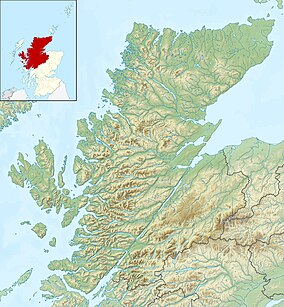Kintail
| Kintail National Scenic Area | |
|---|---|
 Five Sisters of Kintail from Màm Ratagan | |
| Location | Highland, Scotland |
| Coordinates | 57°12′21″N 5°21′8″W / 57.20583°N 5.35222°W |
| Area | 66 sq mi (170 km2)[1] |
| Established | 1981 |
| Governing body | NatureScot |
Kintail (
Name
The area is called Cinn t-Sàile[2] in Scottish Gaelic - which (since the S is silent) is anglicised as Kintail - and literally translates as the Head (ie end) of the Salt Water/Sea. And describes very literally the area sitting at the head/end of Loch Duich (a long fjord-like sea loch).
Area Overview
Kintail is the area inland (east) from the head (end) of Loch Duich. It consists of the mountains to the north of Glen Shiel and the A87 road between the heads of Loch Duich and Loch Cluanie; its boundaries, other than Glen Shiel, are generally taken to be the valleys of Strath Croe and Gleann Gaorsaic to the north and An Caorann Mòr to the east. Although close to the west coast the mountains lie on the main east–west watershed of Scotland,[3] as the northern side of Kintail drains via Glen Affric[4] to the east coast.
The main settlement within Kintail is
Kintail National Scenic Area
Kintail gives its name to the Kintail National Scenic Area, one of the forty
Mountains

The hills to the north-east of Glen Shiel are known as the Five Sisters Of Kintail (Gaelic: Còig Peathraichean Chinn Tàile, although the name is not derived from the
The ridge containing the Five Sisters continues unbroken to the east where it takes in a further three Munros (Sgùrr a' Bhealaich Dheirg, Sàileag and Aonach Meadhoin) which are often known as the Brothers of Kintail.[11] Beinn Fhada (Ben Attow) is the other main mountain in the area.[10]
Ownership
Most of Kintail is owned by the National Trust for Scotland (NTS).[12] The Trust's Kintail and Morvich estate covers 29 square miles (75 km2) and includes the Falls of Glomach, one of the highest waterfalls in Great Britain. The estate was purchased for the NTS in 1944 by Percy Unna,[13] the Scottish Mountaineering Club president who also acquired Glen Coe for the Trust. NTS operate an outdoor education centre in Morvich, which provides accommodation for groups such as school parties undertaking field studies and outdoor pursuits.[14][15]
Wildlife and nature
Bird species found within Kintail include
History
A 5ft 9in, 2,000-year-old
In interviews with
A large boulder lying on the steep southwest slopes of Sgùrr na Ciste Duibhe is known as "Prince Charlie's Stone", as it is the place where
References
- ^ a b "National Scenic Areas - Maps". SNH. 20 December 2010. Archived from the original on 12 June 2018. Retrieved 24 January 2018.
- ^ "Ainmean-Àite na h-Alba (Gaelic Place-names of Scotland) - Kintail". Ainmean-Àite na h-Alba (Gaelic Place-names of Scotland). Retrieved 17 June 2023.
- ^ a b c "The special qualities of the National Scenic Areas" (PDF). Scottish Natural Heritage. 2010. pp. 181–187. Retrieved 29 March 2018.
- ^ a b Ordnance Survey. Landranger 1:50000 Map Sheet 33 (Loch Alsh, Glen Shiel & Loch Hourn)
- ^ "The Team Base at Morvich". Kintail Mountain Rescue Team. Retrieved 20 February 2011.
- ^ "Link Details - Morvich Caravan Club Site". ScottishCamping. Retrieved 20 February 2011.
- ^ "National Scenic Areas". NatureScot. Retrieved 2 October 2020.
- ^ a b "Kintail National Scenic Area". NatureScot. Retrieved 2 October 2020.
- ^ Love of Scotland blog (2 April 2010). "Five Sisters Of Kintail". Retrieved 28 March 2018.
- ^ a b c D. Bennet & R. Anderson. The Munros: Scottish Mountaineering Club Hillwalkers Guide, pp. 193-195. Published 2016.
- ^ "Brothers Ridge - Sgurr a Bhealaich Dheirg". Walk Highlands. Retrieved 28 March 2018.
- ^ "Property Page: Kintail & Falls of Glomach". Who Owns Scotland. 21 September 2010. Retrieved 18 March 2018.
- ISBN 9781849653534.
- ^ "Morvich Outdoor Centre - Kintail and Morvich". National Trust For Scotland. Retrieved 26 March 2018.
- ^ a b c "Kintail Teacher Information". National Trust For Scotland. Retrieved 26 March 2018.
- ^ a b "Kintail and Morvich". National Trust For Scotland. Retrieved 26 March 2018.
- ^ "Cull looms for 'destructive' herd of feral goats". The Scotsman. 7 January 2017. Retrieved 28 March 2018.
- ^ Historic Environment Scotland. "Cille Fhearchair, Shiel Bridge (12000)". Canmore. Retrieved 2 October 2020.
- Birlinn Limited, pages 73-75.
- ISBN 0340639911p. 173

